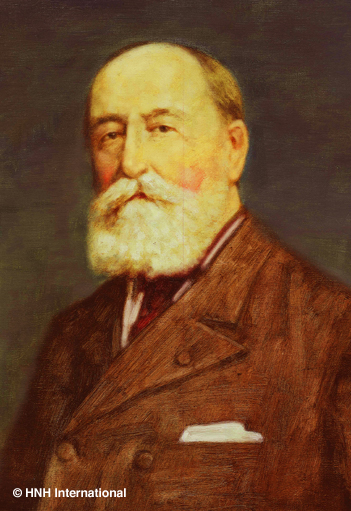
Camille Saint-Saëns (1835-1921)
Camille Saint-Saens’s father died when Camille was three months old. The child began piano lessons at the age of three, and at seven studied with Stamaty. However, rather than a mere child prodigy, he was more of an infant phenomenon who at the age of ten made his Paris debut at the Salle Pleyel performing Beethoven’s Piano Concerto No. 3 Op. 37 and Mozart’s Piano Concerto in B flat K. 450, and was likened to the young Mozart as pianist and composer. He studied composition and harmony with Pierre Maleden and showed a natural aptitude for many academic subjects, the classics, religion, archaeology, astronomy, philosophy and mathematics.
When Saint-Saens entered the Paris Conservatoire at the age of thirteen he studied accompaniment and singing, composition and orchestration with Halevy, and organ with Francois Benoist (1794–1878), gaining a premier prix. He formed friendships with Berlioz, Gounod and Rossini and had a reciprocal admiration for the music of Liszt, also promoting the music of Wagner, Bach and early French keyboard composers.
In the 1860s, already established as a young composer, Saint-Saens travelled in Europe performing his works. He was an exceptional pianist, and befriended Anton Rubinstein after sight-reading his ‘Ocean’ Symphony (No. 2). Rubinstein wanted to conduct an orchestral concert in Paris and asked Saint-Saens to write a work. With the help of a melody written by his pupil Faure, whom he taught at the Ecole Neidermeyer, Saint-Saens took only seventeen days to compose the Piano Concerto No. 2 in G minor Op. 22, which he and Rubinstein performed in May 1868. With another friend, Romain Bussine, Saint-Saens founded the Societe Nationale de Musique which aimed at the performance and promotion of music by living French composers; and during the 1870s he also wrote for the musical press, travelling to Bayreuth for performances of Wagner’s ‘Ring’ cycle.
In 1875 the forty-year-old Saint-Saens married a nineteen-year-old girl, Marie-Laure Truffot. It was an unhappy union that turned to tragedy when both of their sons died within six weeks of each other; one, aged two and a half, fell from a fourth-storey window. The death of his mother in 1888 was another severe blow for Saint-Saens. He went to Algeria to recuperate, a favourite destination that he had first visited in 1873. He continued to compose and perform, and in 1906 decided to visit America where he gave concerts in Washington, Philadelphia and Chicago, returning nine years later, at the age of eighty, to give a series of lectures and performances in New York and San Francisco. Ever the traveller, he then spent four months in South America but by 1921, when he was eighty-seven, he decided to give his farewell performances celebrating his seventy-five years of performing.
Saint-Saens was awarded many honours during his long career. These include his election to the Academie des Beaux-Arts in 1881, being made an officer of the Legion d’honneur in 1884, and a Grand Officier in 1900. As well as being awarded the Cross of Merit by Emperor Wilhelm II, he was named president of the Academie des Beaux-Arts in 1901 and awarded the Grande Croix of the Legion d’honneur in 1913.
Saint-Saens entered the recording studio twice, first in 1904 and later in 1919. Initially, the Gramophone Company approached him for nothing more than a testimonial praising the merits of the gramophone and its reproduction of music. However, within two weeks Saint-Saens was in the studio, ready to be recorded. At both sessions he made some recordings as accompanist: in 1904 to an excruciating singer (whom recording engineer Fred Gaisberg unbelievably described as the finest contralto voice he had ever heard), and in 1919 to violinist Gabriel Willaume. However, the nine solo sides are of interest since all are of Saint-Saens’s own compositions. In 1904 he recorded five solos, the most impressive of which is an improvised cadenza to his work for piano and orchestra Africa Op. 89. This is a technically fiendish part of the work that the composer plays with great gusto. Two waltzes, written a few years before, are played with charm and a light touch, a characteristic of Saint-Saens’s pianism. The sound he creates, albeit through primitive recordings, is of a clear, shallow tone, employing a light touch and little pedal. Most important of the solo recordings are extracts of the first movement of the Piano Concerto No. 2 in G minor Op. 22. Rubato is held well in check, the composer never lingering over the melody, whilst the Rhapsodie d’Auvergne displays Saint-Saens’s extraordinary digital dexterity although the sound of the recording is poor.
Although the Gramophone Company knew these recordings were an important document of the most famous of living French composers, they were also aware that by 1919, pianists such as Paderewski could sell many more discs. However, perhaps again as a favour to posterity rather than as a commercial venture, Saint-Saens was asked to record again. He was eighty-four years old by this time, yet his age cannot be detected from his playing. He again recorded his Valse Mignonne Op.104, and an early work from 1862, his Premiere Mazurka which has the best sound from these sessions.
© Naxos Rights International Ltd. — Jonathan Summers (A–Z of Pianists, Naxos 8.558107–10).






























